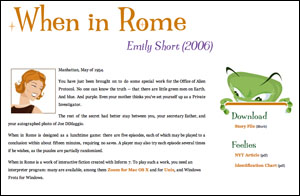
Inform 7 Home Page / Documentation
§25.13. Website templates
Web pages are very idiosyncratic things and Inform will almost certainly not produce exactly what we want. What it actually does is to take an existing "template" web page, and paste in the relevant information to make the final product. So by starting with a different template, we can end up with an entirely different-looking web page: like this one, for instance -

The template ordinarily used by Inform is called "Standard" and comes built in. (A second built-in template, "Classic", imitates the look used in 2005-08. The word "classic" here is to be understood in the sense of Classic Mac OS, the classic Doctor Who adventure "Time and the Rani", classic Mayan civilisation, and so forth - really pretty awful.)
Any other templates we must make ourselves, giving each one a different name, by convention a single word. In this section, we'll make a new one called "Platinum".
Suppose we write:
Release along with cover art, a "Platinum" website, a file of "Collegio magazine" called "Collegio.pdf" and a file of "The mating call of the green wyvern" called "Mating Wyverns.mp3".
This is identical to the previous version except for the "Platinum": note the quotation marks. When it needs to find a template, Inform searches the following places in sequence:
(a) the "Templates" subfolder of the project's own .materials folder, if this subfolder should exist;
(b) the "Templates" folder in the user's own library - on Mac OS X, this is:
~/Library/Inform/Templates
or on Windows:
My Documents\Inform\Templates
or on Linux:
/Inform/Templates
(c) the built-in stock of templates, currently only "Standard" and "Classic".
What Inform looks for is a folder name matching that of the template - so in our case we need to provide a folder called "Platinum", and put it in either location (a) or (b).
The template folder is expected to contain some combination of the following files:
There are two HTML pages here, one for the main front page, the other for pages of displayed source text (if we release along with the source text - see later in the chapter). The CSS file defines styles of text - sizes, fonts, colours, and so on - and positions material on the page. The "(extras).txt" - which is optional, of course - allows additional HTML pages, images, movies and so on to be added.
If any of these is missing, Inform uses the one in "Standard" instead. In practice, this means the easiest way to create a new template is to supply just a new CSS file, which can change the colour, font, type size, and position of more or less everything in the site:
We probably want to start from the "Standard" version of "style.css" and edit in a few changes; the easiest way to get a clean copy of "Standard"'s CSS file to work on is to release the project with a "Standard" template, which causes this default "style.css" to appear in the "Release" subfolder of the project's .materials folder. (But it's wise to move the file out of "Release" before starting to edit it - files in "Release" are overwritten by Inform whenever a release is made.)
This is not the place to describe how CSS works. CSS is a more or less universal format today for describing how web pages should look - their style rather than their content. A dazzling variety of possibilities can be seen at the excellent:
but of course there are many, many other textbooks and websites which describe CSS.